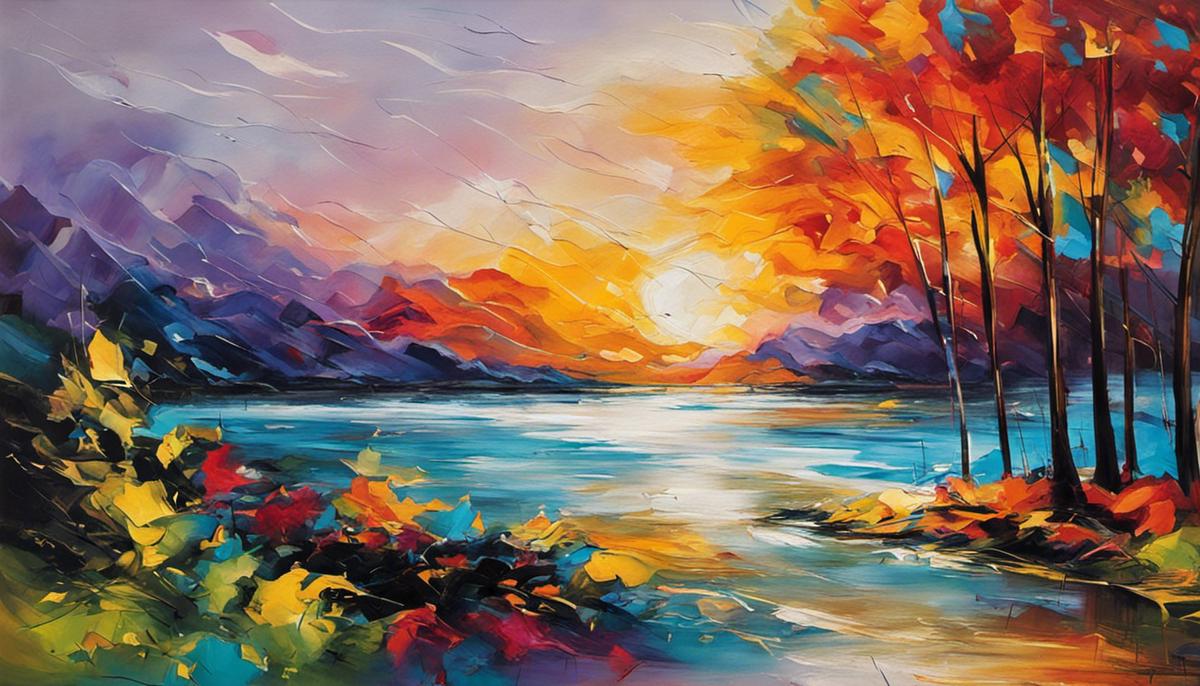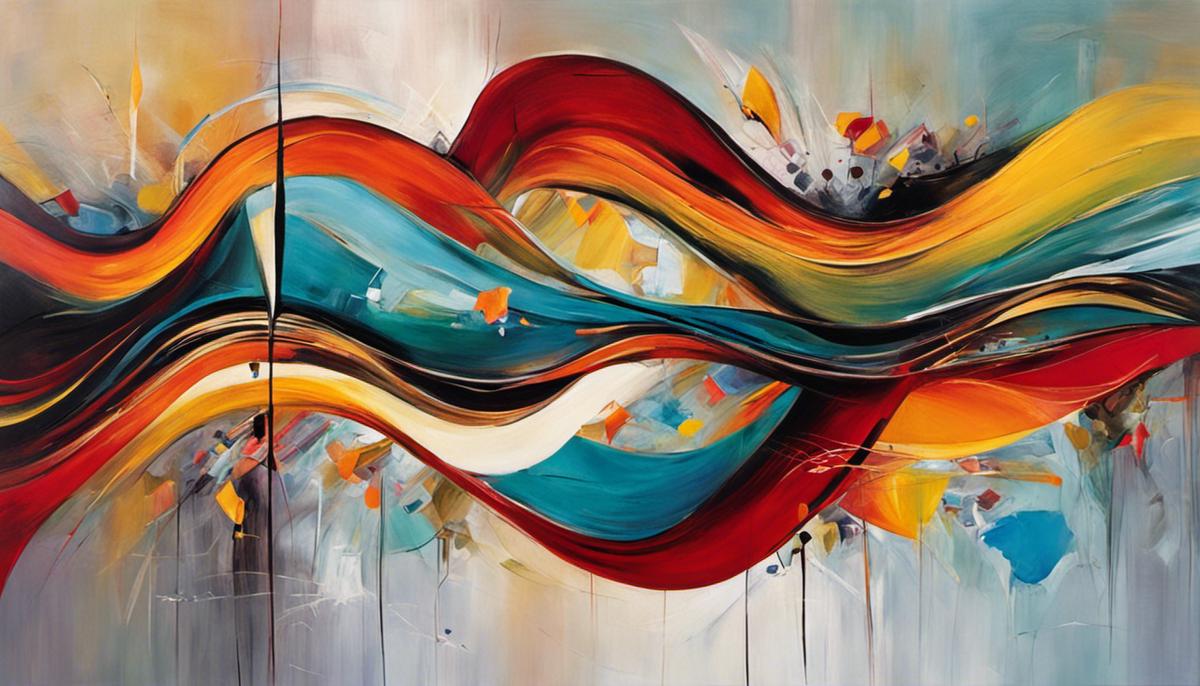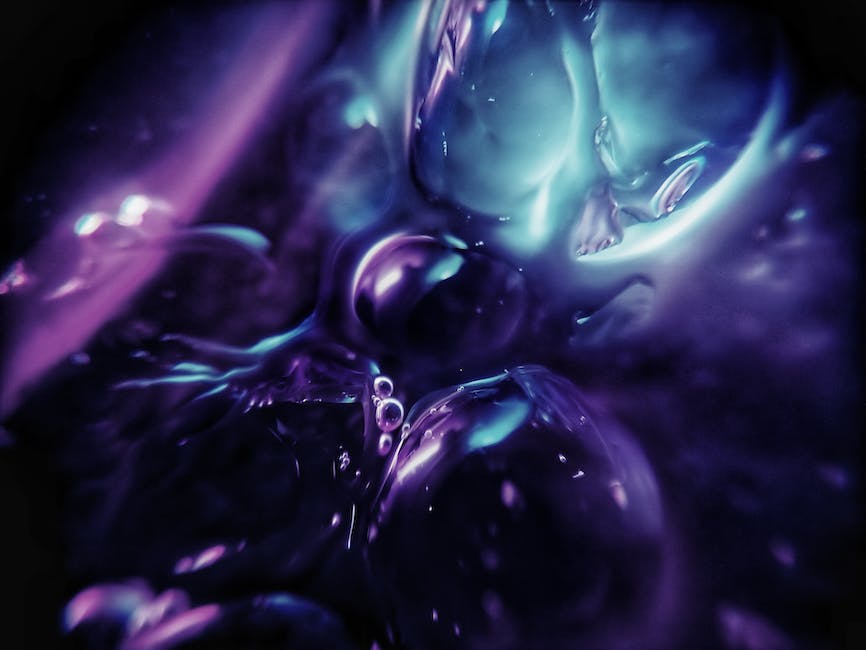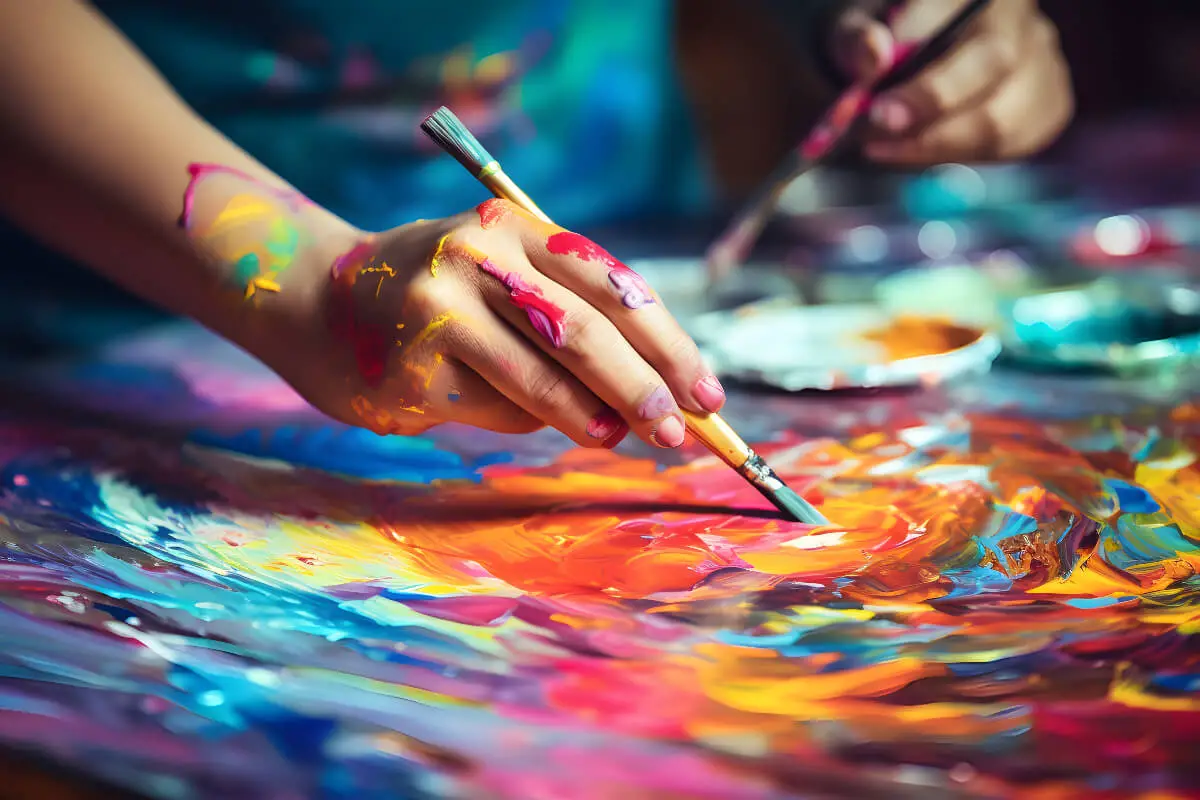Abstract art’s complex amalgamation of colors, shapes, and visual elements offers a compelling deviation from traditional art styles. It liberates the imagination and surpasses literal representation to tap into viewers’ raw, emotional, and intellectual responses.
Predominantly non-objective, it invokes unique interpretations and personal connections that transcend common language. This exploration into the fantastic world of abstract art seeks to enlighten us on its fundamental principles. It presents insights into the significant artists that shaped this movement, the versatile techniques employed, and the profound influence it permeates into our modern society.
Table of Contents
- Understanding Abstract Art
- Significant Abstract Artists and Their Works
- Abstract Art Techniques
- The Impact and Influence of Abstract Art in Modern Society
- Related Questions
Understanding Abstract Art
Abstract art. A term that transcends the realms of the natural and tangible, seeping into dimensions hitherto unseen and unfelt. By its very nature, it rejects the confines of reality, transcending to an intellectual and emotional paradigm where creativity flows unfettered.
To understand the essence of abstract art, one must delve into the kfundamentalprinciples that define this enigmatic movement. These tenets, however, are not clear-cut or universally accepted. They’ve evolved through the years, morphing and intertwining into a labyrinth of interpretation and analysis.
Perhaps the most crucial principle of abstract art is the severance from reality. Unlike representational art, where the observer identifies familiar shapes, figures, and landscapes, abstract art severs these ties, presenting the audience with an unacquainted realm brimming with imagination and subjective interpretation. The canvas is no longer a mirror to the world but a portal into the artist’s psyche.
Equally significant is the emphasis on the emotional and intellectual proposition of the work. Unlike other art styles that indulge in meticulous details or narrative storytelling, abstract art focuses on conveying an emotional impact or intellectual stimulus. It becomes a medium of raw expression, unshackled by the chains of literal representation.
The use of shapes, forms, colors, and strokes are all pivotal elements in the world of abstraction. They’re not just mere tools in the hand of the artist but serve as narrative devices, each with its distinguished story. From Kandinsky’s dynamic lines in “Composition VIII” to Matisse’s bold use of color in “The Snail,” each stroke’s discord, synergy, and juxtaposition create a dance of intrigue, a story waiting to unfold.
Another defining principle lies in the inherent subjectivity of abstract art. Where one might see chaos, another might find tranquility; where one discerns despair, another may discover hope. It entails a personal connection, where the viewer’s experiences, emotions, and viewpoints shape the interpretation. Each artwork is a Rorschach test, revealing intimate insights into the observer’s psyche.
However, to delve deeply into the abstract art movement, one cannot ignore one of its subtle yet profound principles: the appreciation of the process. Abstract art, in many aspects, reveres the journey of creation as important as, if not more than, the final product. The artist’s dialogue with the canvas, the dance of the paintbrush, and the emotional churn of transforming the intangible into the tangible make the heart of abstract art beat.
Abstract art continues to challenge, provoke, and bewitch art enthusiasts and novices, traversing previously unfathomed depths of human expression. Understanding its principles not only offers a guide into this mystical universe but also ignites a more profound affinity for this remarkable art movement, which continues to morph, evolve, and abstract.

Significant Abstract Artists and Their Works
Pioneers of the Abstract Movement: Artists and their Masterpieces
Artistry is a cultivated talent that transcends boundaries and norms. The abstract movement is a prime example of this transcendence, a paradigm shift from physical representation to an interpretive plane.
Harnessing emotional ambiance and intellectual complexities, this movement has introduced artists who have changed the face of art, turning forms, colors, and strokes, the lifeblood of their works, into narrators of their stories.
In the grand tapestry of the abstract movement, the names of Wassily Kandinsky, Piet Mondrian, and Jackson Pollock emerge with the most vibrant threads. These visionaries unfolded a new world of artistry laden with emotion, intellect, and a relentless pursuit of pushing boundaries.
Wassily Kandinsky is considered the pioneer of abstract art, steering art away from the remits of physical representation to the expansive sea of emotion and thought. His most significant work, “Composition VIII,” radiates with geometric figures asserting themselves against a stark white background. Painted in 1923, the piece is a symphony of precision, a celebration of the dialogue between forms and colors, a narrative only the brave would dare to engage.
Next, the name Piet Mondrian commands respect in the abstract realm. Breaking away from established aesthetics, Mondrian created a style synonymous with his name – neo-plasticism. His vision to pare art down to its essential elements resulted in both familiar and alien pieces.
A testament to this vision is “Broadway Boogie Woogie” (1942-43), an intriguing tableau of vibrant, pulsating squares. The piece serves as a testament to his unique artistic conviction, taking inspiration from the ever-changing rhythm of New York City.
Last but certainly not least, Jackson Pollock emerged as a revolutionary force in the abstract movement. Exploring the raw energy of art, Pollock created the drip painting technique, propelling the artistic process to the forefront of the narrative.
Among his numerous groundbreaking works, “No. 5, 1948” stands monumental. This work is an emotional outpour, a chaotic dance of colors and strokes that unravels a voyeuristic journey into Pollock’s approach and psyche.
A nod to the underlying ethos of the abstract movement also unearths the sublime contributions of artists such as Joan Miró, Mark Rothko, and Robert Delaunay. With their distinctive approach, each artist has contrived a narrative, a universe within their works that resonates with the emotional and intellectual ethos the movement sought to articulate.
These artists, alongside others who have dared to explore the abstract realm, exemplify the boundless potential of human emotion and intellect. Their creative journeys have transcended conventional narratives, paving the way for future generations to explore and appreciate the enigmatic world of abstract art.
Their masterpieces continue reverberating through time, their legacies imprinted in the annals of art history, and their brush strokes embody the idiosyncratic narrative unique to the abstract movement.

Abstract Art Techniques
Delving into the intricacies and techniques of abstract art often feels akin to traversing a labyrinth of color, form, and texture. The result, however, is an exhilarating exploration of creativity and emotion, challenge and catharsis.
One of the most prominent techniques in abstract art is gesturalism, a process where the artist’s movement is integral to creating each piece. It is not simply the final image that matters but the physical act of painting itself.
This technique was perhaps best personified by the post-war Abstract Expressionist Willem de Kooning, whose work ‘Woman I’ exemplifies the controlled chaos emblematic of this style.
Using color to emphasize emotion and construct atmosphere is another crucial technique. Who amongst us can stare into the depths of Rothko’s ‘Red, Orange, Tan and Purple’ and not be profoundly moved? Here, the technique translates to a deep, multi-layered use of color to evoke an emotional response.
Through extensive, soft-edged blocks of color that seem to hover in a state of suspension, Rothko teaches us subtlety and the expressive power of color.
Collage is another commonly used technique within the realm of abstract art. Providing an opportunity for an exciting interpretation of materials, this method emphasizes the aesthetic of the superficial. Magnificent examples of this can be found in the Dadaist works of Hannah Höch and the contemporary digital collages of today’s artists, consisting of various elements gathered in a composition void of familiar reality.
Furthermore, Minimalism, with its paramount simplicity, embodies another central abstract technique. Agnes Martin, known for her simple yet stunning hand-drawn grids, illustrates the power of less is more. Yet, the simplicity of her artistry belies its complexity, compelling the audience to confront the depths of their psyche provoked by mere lines and pale colors.
In the realm of sculpture, the technique of spatial relationships defines the work of Alexander Calder. His kinetic sculptures, or “mobiles,” revolutionized abstract art, transforming static sculptures into moving works that engage with their environment. Here, the technique lies in a new relationship between space and form, activating a dialogue between the artwork and its surrounding environment.
Although these techniques are a seminal part of abstract art, they barely scratch the surface of the exhaustive list of strategies potentialized by the form’s inherent unconventionally.
Each artist, adhering to or rebelling against these techniques, contributes to the thriving and ever-evolving realm of abstract art, embodying Mark Rothko’s belief that “The progression of a painter’s work…will be toward clarity; toward the elimination of all obstacles between the painter and the idea, and between the idea and the observer.” The journey through abstract art thus remains an enigmatic, unending revelation in technique and self-expression, marked by the profound echoes of the artist’s creative liberation.

The Impact and Influence of Abstract Art in Modern Society
Delving deeper into the realm of abstract art, the extent of influence it has had on modern society and contemporary art cannot be undermined. Abstract art’s impact can be seen in our everyday lives, from architecture to commercial designs, art installations, and even popular culture across various forms of multimedia. In many ways, the nuances of this art form have seeped into our consciousness subtly and significantly.
For example, the rise of architecture in the mid-twentieth century symbolized a shift towards distinct creative freedom and innovation. The Guggenheim Museum in New York City, a work of art by the celebrated architect Frank Lloyd Wright, displays an almost sculptural aesthetic that alludes to the influence of abstract art.
The stark departure from conventional linear structures embodies the core tenets of abstract art – the courage to stray from the norm, experiment, and see the world through a different prism.
Abstract art, too, has found resonance in commercial designs, logos, and packaging. Many brands, recognizing this style’s potency in sending distinct messages and projecting an image, have adopted its features.
Look no further than the bold color schemes and fluid lines that grace many products on the supermarket shelves. Aligning with the theory of Wassily Kandinsky, who firmly believed that colors and shapes could trigger profound emotional responses, these designs actively engage their audience and forge a direct connection with consumers on a deeper psychological level.
The influence of abstract art, of course, transcends beyond the commercial and business realms. Moving onto cinema and retail, abstract themes have provided filmmakers and fashion designers with fresh perspectives and stimulated new avenues of creativity. From the abstract patterns on a dress to non-linear, fragmented storytelling in films, a discernable echo of the abstract art movement permeates our cultural landscape.
Yet, perhaps nowhere has the influence remained as pronounced as within the world of art itself. The development and popularity of digital art, performance art, and installation art all bear the indelible fingerprints of the abstract genre.
The concept of ‘art for art’s sake,’ free from the constraints of replicating reality, a principle embraced by abstract artists, is evident in these branches of contemporary art.
In essence, the gift of abstract art to modern society and contemporary art lies in its radical openness – its capacity to inspire innovation and a continual reassessment of what defines art itself. It’s an invitation to communicate sans words, feel rather than understand, and view the world through a dynamic, ever-changing lens. This, indeed, is the enduring legacy of abstract art.

A profound form of expression, abstract art transcends traditional artistic norms and manifests in diverse platforms within our society. Its powerful influence can be perceived in contemporary art, design, and sectors not traditionally associated with the arts.
Foremost pioneers like Wassily Kandinsky, Piet Mondrian, and Mark Rothko laid the foundation for this compelling art form through their innovative techniques and significant works.
Their legacy continues to resonate, influencing the creative processes across different mediums, encouraging new interpretations, and stimulating our sensibilities. The impact of abstract art is a testament to the unrestrained capacity of human creativity and the endless possibilities birthed through it.
Anita Louise Art is dedicated to art education, great artists, and inspiring others to find and create their art. We love art that uplifts and inspires. #ArtToMakeYouSmile! #ArtToMakeYouHappy!
If you want to see any of my art, you can find out more by clicking here. If you are interested in what inspires me and my paintings, you can discover more by clicking here.
We have a free newsletter and would love you to be part of our community; you can subscribe to the newsletter by clicking here. I would be happy to talk to you if you have any questions. You can reach me, Anita, by clicking here.
Subscribe to our Anita Louise Art YouTube Channel with great videos and information by clicking here.
Join us for our podcast “5 Minutes With Art.” Spend 5 minutes a week with us to discover and learn about great art and artists. You can find out more about our podcast by clicking here.
Related Questions
Abstractionism In Art Defined: Unlocking Abstract Expression
Among one of the most influential art movements, abstractionism stands as a beacon, reshaping the trajectory of modern art. Abstract art, also known as abstractionism, captivates with its departure from conventional depictions of the visual world. Read on, we explore the essence of abstractionism, delving into its fundamental nature, diverse forms, and the underlying concepts that fuel its creative endeavors.
By clicking here, you can learn more by reading Abstractionism In Art Defined: Unlocking Abstract Expression.
15 Most Famous Abstract Art And Why They Are Famous
Abstract Expressionism is a term applied to the art developed by American painters in the 1940s and 50s. It is associated with the New York School art movement, which signified a change in the world’s art center from Paris, France, to New York City. Gestural brushstrokes characterize the abstract expressionism art movement, mark markings, and the overall impression of spontaneity in the artwork.
You can learn more by reading the blog 15 Most Famous Abstract Art And Why They Are Famous by clicking here.
Abstract Painting Ideas – A Wealth Of Inspiration Awaits
We understand how hard it can sometimes be to find inspiration for Abstract painting, so we will delve into ten suggestions to help artists discover new avenues of inspiration for their abstract artworks. Everything from nature and life experiences to other great artists’ works can help you find the subject matter to paint.
By clicking here, you can discover more by reading Abstract Painting Ideas – A Wealth Of Inspiration Awaits.

